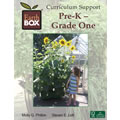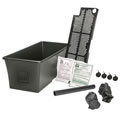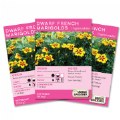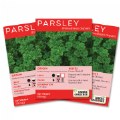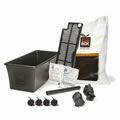Earthbox Early Learning Site Pack
4 years & up. Introduce the wonder of growing things with five (5) hands-on, age appropriate activities and one (1) Ready-to-Grow earth box kit (includes one earth box, potting mix, fertilizer, dolomite and casters. Measures 29"L x 11"H x 13.5"D.
Plant… Instruct… Harvest
Choose what you want to grow, plant the seeds or seedlings in this revolutionary box and observe science at work. Children will experience the responsibility of caring for their crop, the thrill of observing the different parts of their plants, and learn about the growing cycle as you study the transformation process together. The wonder of life and hope of the harvest are timeless experiences for children.
The Science of the Earth Box
The unique design of the Earth Box is just the beginning of science at work for this self-contained growing system! The black screen at the bottom serves a very important function. Not only does it keep the potting mix from falling into the water reservoir, but it also holds the potting mix far enough above the water to allow space for air. The roots of a plant need air, and this is where they get it. Water only comes into contact with the potting mix in two places — the two square holes in the corners of the screen. The potting mix falls into these holes and fills them up. Earth Boxes aren't watered the same way plants in a garden are watered. Instead of watering from above, they are watered from below by pouring water into the watering tube. This tube leads directly to the water reservoir. The overflow hole in the side of the Earth Box prevents the addition of too much water, this hole makes it impossible to over water the plants in an Earth Box. The potting mix in the two corners acts as a wick and become saturated with water. Water then moves up through the dry potting mix by the principle of capillary action. When a plant absorbs water from the potting mix, more water is pulled up from the reservoir. As long as the reservoir is kept full, the plant will always have the proper amount of water.
During the set up of the Earth Box, fertilizer is placed on top of the potting mix. Just like water is pulled from the reservoir as the plants need it, fertilizer is pulled from the top of the potting mix. The plastic cover that comes with your kit is another important feature. It keeps rain out, helps prevent evaporation, helps keep insects and other pests out of the potting mix and prevents weeds from growing in the Earth Box.
The success of growing plants in an Earth Box is based on numerous scientific principles that can be investigated in further detail in the Earth Box Curriculum Support Packages.
What Customers are Saying
"The Earthboxes provided an affordable, simple way to bring gardening into an elementary school classroom! My high school students and FFA members prepared and delivered their own lessons in plant anatomy and physiology to our partner (5th grade) classroom. As they promoted agricultural literacy and taught real-life science, I was able to assess their understanding of the concepts."
Michelle Sutton
Teacher & FFA Advisor
Agricultural & Environmental Science
TST BOCES - New Visions Program
"At Doris Hancock Elementary School, in Las Vegas, Nevada, an incredible experience is underway. The GATE (Gifted and Talented Education) students are working alongside the Kindergarteners and students in Special Education to develop a school garden. Through the planting, maintaining, and tracking the growth of the vegetables and herbs in the EarthBoxes, students are able to learn about the environment and how plants grow. This is a perfect example of how NATURE and NURTURE work together to provide students with an optimal learning environment. Valuable and relevant, hands on activities create the opportunity for our children to integrate core curriculum with real world experiences. Relationships are being fostered between our students of various age and ability levels, while they measure, observe, draw and journal all about the plants and their experiences together. This coming school year we hope to integrate the nutrition aspect of the program by incorporating a Healthy Hancock Hawk Cookbook with recipes created by our students and families using the fruits, vegetables, and herbs we grow in our Earthboxes. As our program and crops grow, we look forward to using our Earthboxes as a source for community service projects. Thanks, Earthboxes!"
Hadassa Lefkowitz
GATE Specialist
"The EarthBox was an invaluable tool for my after-school program. We used the EarthBox to learn core scientific concepts. The hands-on environment allowed some of my more academically reluctant students an opportunity to shine. Students who had difficulty in the traditional classroom gained new confidence by leading the group in the hands-on activities of planting, maintaining, and harvesting our EarthBoxes. The controlled environment of the EarthBox allowed us to perform experiments and witness scientific concepts in action; it also insured the health of our plants and the wealth of our harvest. Thank you, EarthBox!"
Brigid Philbin
Nay Aug After School Program
Science Made Easy With the EarthBox®
Teachers, are you concerned with teaching science concepts that you are not entirely comfortable teaching? Do you worry about student comprehension of various scientific principles? With the EarthBox® Pre School-12th Grade curriculum support packages, there is no need to worry. Each lesson includes detailed, scientific explanations of the underlying scientific principles of the lesson in simple, easy to understand language that will help you to become an expert at the scientific principles and properties of water, light, soil, plants and nutrition. Students learn the material by experiencing the science in an enjoyable, hands-on format with student driven activities that address all learning styles and completely engage the student in the learning process.
The Introductory Material for each curriculum support site package includes an Overview, a Standards Alignment Matrix, a listing of the National Science Standards delineating relevant standards for Math, Language Arts and Consumer Science and an explanation of the science behind the EarthBox®.
The lessons, many of which feature the EarthBox® as an integral learning tool, provide students with activities that help to build on, and reinforce the knowledge gained from traditional instruction. In an effort to assist teachers in their challenge to meet the rigorous goals of No Child Left Behind and to cover several standards most of the lessons address multiple standards from several content areas. Most importantly, the lessons are fun yet challenging. The sense of ownership and responsibility that students gain from growing and caring for plants in their classroom EarthBoxes will stay with them for years to come.
“I am a 6th grade science teacher and have been using the EarthBoxes with my students for a number of years. The students have loved growing and harvesting the vegetables. This year, however, I used the EarthBox curriculum to supplement my teaching and it was wonderful. It is based on good science and is very teacher friendly. I would highly recommend it to other teachers.”
— Ann Cruikshank
Pre-K/12th Grade Correlated and Graduated Instruction
The EarthBox® support curriculum structure intentionally and substantially increases student understanding of the science behind light, soil, water, plants and nutrition from grade level to grade level. Pre school students grow plants from seeds in their classroom to learn about the life cycle and the interconnectivity of plants, light, water, soil and nutrition. Elementary students learn scientific principles behind light, water, soil, plants and nutrition and middle school students perform science-based experimental activities that develop critical thinking skills. High School students perform authentic scientific experiments.
Student Centered Approach
All lessons focus on student-centered guided inquiry exercises. Lessons begin with a question, such as, “How does the direction of light affect plant growth?” Students set up an experiment and formulate hypotheses about the outcome. They make predictions about scientific phenomena and experiment with them before they are taught the concepts in the lesson. This methodology minimizes learning via direct teacher lectures and encourages students to develop critical thinking skills. Students gain a greater understanding of underlying scientific principles and retain more of what they learn with the hands-on, interactive approach. The inquiry-based activities also encourage creative thinking and teamwork, two essential skills students need throughout their education and life.
Using EarthBoxes in the Classroom
The EarthBox® minimizes many of the challenges of growing plants indoors. The watering reservoir ensures that plants grown in EarthBoxes both indoors and outdoors receive the same, ideal amount of water. The fertilizer strip, protected from the elements by the plastic cover, provides a steady, proper amount of nutrients regardless of the outdoor weather or indoor climate. Yet, a truly significant difference between growing plants indoors and outdoors does exist. It is the amount and quality of light that they receive. Non UV-protected classroom windows with Eastern or Southern exposure of 6-8 hours of daily sunlight provide enough light to perform the lesson activities that involve growing plants. Minus these conditions, grow lights can supplement or replace the natural sunlight. Grow light bulbs look like normal fluorescent bulbs, but are enriched in the blue and red end of the visible spectrum. They provide plants with proper light and color intensity for adequate growth. Standard fluorescent bulbs are no substitute for grow light bulbs. If you use a grow light setup in your classroom, the light should not be left on continuously–this can harm the plants. Install a light timer and set it so that the light is on for 14-16 hours a day.
All classrooms are not created equal. Classrooms have different lighting, temperature and humidity conditions. Plants in differing conditions will grow at different rates. If plants grow well in a classroom, the time intervals between the experimental treatments will be shortened. On the other hand, when plants take longer to grow, then the experimental treatment time will need to be lengthened.


